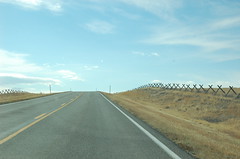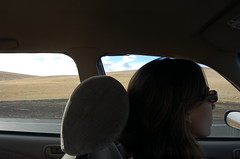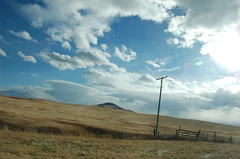 The first mile along the gravel road that might or not be the right road is always the most difficult. There’s the fear that the nine-year-old Toyota Corolla will not prove up to the rough surface. What if we break down? Will we have to capture the llama standing guard over a flock of sheep a few fields back to protect us from wolves as begin the long slog back to town? There’s also the vague sense of trespass, exacerbated by the knowledge that most everyone in these parts has guns. But I take comfort, somehow, in the speed limit signs, token representatives of civic government, like little embassies, assuring us that we are in a public place after all and can count on the right of free passage, provided of course that we do not exceed forty miles an hour. Gradually the rumble of gravel under the tires fades into the background. As for the wolves, well, we’ll cross that bridge if we come to it.
The first mile along the gravel road that might or not be the right road is always the most difficult. There’s the fear that the nine-year-old Toyota Corolla will not prove up to the rough surface. What if we break down? Will we have to capture the llama standing guard over a flock of sheep a few fields back to protect us from wolves as begin the long slog back to town? There’s also the vague sense of trespass, exacerbated by the knowledge that most everyone in these parts has guns. But I take comfort, somehow, in the speed limit signs, token representatives of civic government, like little embassies, assuring us that we are in a public place after all and can count on the right of free passage, provided of course that we do not exceed forty miles an hour. Gradually the rumble of gravel under the tires fades into the background. As for the wolves, well, we’ll cross that bridge if we come to it.
And suddenly these thoughts are swept away by the exhilaration of discovery, success, like what Peary must have felt when a second and third check of his instruments confirmed that he was standing at long last on the North Pole. There, at the five-mile mark, just where it should be if (1) this is the right road and (2) I’m reading distance on the map correctly, the long-sought goal: ten or so silver silos and a jumble of long low cream-colored dormitory-like structures on the right side of the road, substantial modern buildings that are a far cry from the modest, weather-beaten, barely-there ranch houses we’ve seen along this road so far. The outpost of a religious sect whose members are “highly skilled agriculturists, formidably competitive with family farmers and ranchers” if ever there was one.
The road turns sharply to the south, just like the map says it should. Tucked into the corner of a field, just inside the fence, as final confirmation, a sign: “New Rockport Colony.”
Also: “Disease Control Program.”
Also: “Keep Out.”
We stare down the road into the colony for a long minute, and then, since we have no particularly compelling reason to ignore this sign, A. backs the car around and points us back toward Choteau and our motel. On the way, we cross paths with the first vehicle we’ve seen on this road, a big blue Ford pickup headed for the colony. The driver, a shadow in a broad-brimmed hat behind the tinted glass nods and waves as he passes. Technically we have failed, but my heart is light and full of song for the glorious beauty of this particular gravel road in this particular state at this particular moment in my young life.
 We first heard of the Hutterites not long after arriving in Missoula this summer. Our main source was a new friend who teaches at a Hutterite school, and the impression we formed from a not-very-detailed conversation with her was basically that Hutterites are in some vague way “like Amish and Mennonites,” live off by themselves on “colonies,” and do a lot of farming. That’s about all we had to go on when the sign appeared in front of Pattee Creek Market in late October: “Reserve Your Hutterite Turkey Today!” One day we stopped in and ordered one for pick-up on the Tuesday before Thanksgiving, a sixteen pounder that would be big enough to share with the international students and other temporary orphans from the university we had decided to invite over to share in the warmth and joy of our happy home.
We first heard of the Hutterites not long after arriving in Missoula this summer. Our main source was a new friend who teaches at a Hutterite school, and the impression we formed from a not-very-detailed conversation with her was basically that Hutterites are in some vague way “like Amish and Mennonites,” live off by themselves on “colonies,” and do a lot of farming. That’s about all we had to go on when the sign appeared in front of Pattee Creek Market in late October: “Reserve Your Hutterite Turkey Today!” One day we stopped in and ordered one for pick-up on the Tuesday before Thanksgiving, a sixteen pounder that would be big enough to share with the international students and other temporary orphans from the university we had decided to invite over to share in the warmth and joy of our happy home.
Now, I have this writing habit or you could call it call a compulsion and sometimes the energy and desire to do something about it courses through me like fire in prairie grass and there is nothing for it but to either find something to write about or pour myself a glass of Maker’s Mark. On the Thursday before Veteran’s Day weekend we were out of whisky and it occurred to me that maybe I could travel to the Hutterite colony where our turkey was going to come from and write about the trip. It would be a quirky travel essay contrasting the Hutterites’s way of life with ours, dazzling readers along the way with great swaths of poetic description of the astonishing terrain of the state of Montana, our new home. It would be like journalism or something. Maybe I could even submit it somewhere. I called the market and learned that our turkey would come from either the New Rockport or Birch Creek colonies, both out near Choteau, two hundred miles east of Missoula as the car drives, which seemed doable. A. looked only slightly dubious when I proposed the trip.
The day before we left, I got on-line and started to read up on Hutterites. As I began my research, it felt thrillingly ironic and post-modern to be learning about these primitive farmers via the internet, and I even took some notes on this irony, thinking it would make for a good passage in my essay. But as I read further I learned that Hutterites don’t exactly lead primitive lives. I read some more, and then I crossed out all the ironic stuff and collated my notes into the kind of wise yet approachable paragraph that all the best essayists use to sprinkle book learning in among their personal impressions in order to keep their readers from noticing how self-indulgent the overall essay is:
There are in Montana small communities of a close-knit Christian sect whose members call themselves Hutterites. Like Amish and Mennonites, with whom they trace their origins back to the sixteenth century and certain disagreements with the mainstream of the Protestant Reformation, Hutterites are Anabaptists, meaning they are not baptized at birth but rather as adults, and then only after making an informed, free-will confession of faith. Also like Amish and Mennonites, Hutterites are pacifistic, reclusive, and suspicious of many aspects of the modern world. But this suspicion does not lead Hutterites to reject modern technology per se: though they disapprove of photography and television, they willingly use telephones, automobiles, and, most importantly, state-of-the-art farming equipment. And unlike Amish and Mennonites, Hutterites do not believe in personal property. They own their land and equipment in common, so that each colony operates essentially like a small farming corporation, with all of the efficiency, “rationality,” and economies of scale this permits. As a result, they are considered highly skilled agriculturists, formidably competitive with family farmers and ranchers. In fact, at a recent conference on real estate and development issues facing Montana and the west, I saw one rancher just about swallowing his tongue in an effort not to say something impolitic about his neighbors, the Hutterites.
In addition to using phones, Hutterites have answering machines. I know because I left a long embarrassing message on one the day before we left for Choteau. The message was a recap of the long embarrassing explanation I’d given to the woman of few words who answered the New Rockport Colony’s main listed phone number. I’m a writer, my wife and I just moved to Montana, I’m working on a series of essays about exploring our new home state, I wanted to write about where our Thanksgiving turkey is coming from. I’ve always found that identifying myself as a writer when no one is paying me to be one is extremely difficult, especially when I’m asking for something special or out of the ordinary as a result of this alleged “fact.” Logically, I know that this is just what I have to do if I want to write the kind of essay I had in mind here, but that doesn’t make it any easier.
She asked if what I was writing would end up in a book. “It might,” I said, trying to sound confident, i.e., “it might” end up in a book if there’s room in my book after I put all the other things into my book, but there are books involved, certainly, I’m a real writer, why wouldn’t it end up in a book? She said I would have to talk to the guy who raises the turkeys. I dialed the number she gave me and that’s when I discovered for myself that Hutterites have answering machines. I talked to the turkey guy’s answering machine for so long that a loud beep cut me off in mid-sentence to indicate that I’d run out of tape.
He never did call me back.
 We set off from the motel around four. A., who is really very understanding of my strange urges, offers to drive so that I can make observations and talk into my tape recorder. Just to orient ourselves, we first take a quick spin through the little town where we’ll be spending the night: Choteau, MT, on the eastern Rocky Mountain Front. The main street is mostly empty, the shops are mostly dark.
We set off from the motel around four. A., who is really very understanding of my strange urges, offers to drive so that I can make observations and talk into my tape recorder. Just to orient ourselves, we first take a quick spin through the little town where we’ll be spending the night: Choteau, MT, on the eastern Rocky Mountain Front. The main street is mostly empty, the shops are mostly dark.
In a parking lot, under the blank pitiless gaze of a rusting Tyrannosaurus Rex statue, we consult the map. Then we head east, across the tracks, and out of town.
We wind out of Choteau on state road 221 and turn north, after about two miles, on state road 220. From the Rockies to Choteau to this very turn, we’ve been driving in a region of rolling hilly grasslands with colors in about a thousand different shades of brown, gold, and yellow: wet blonde hair, beach sand at sunset, old wedding rings, and so on. Cresting a short rise on 220, we go from plains to plane, geometric that is, a glass-flat muddy-looking expanse of farm fields extending as far as the eye can see, except of course for where they run into the cloud-capped Rocky Mountains to the east west. The sun throws the car’s long shadow on the stubbly field beside the road. We pass hay bales stacked in the approximate size and shape of a semi trailer. Cows slump on the ground immobile as glaciers, horses bend graceful necks down to feed, and the occasional lonely house peeks out from its little palisade of trees.
According to the map, we are looking for the second “improved” road north of the intersection of 221 and 220, but we are hampered both because the roads are not labeled on the map and we have no idea what is meant by “improved.” We pass several fine gravel roads, labeled with numbered green street signs just like they would be downtown somewhere (17th, 18th, 19th, etc.), but I am at first convinced that the mapmakers wouldn’t have used such a thick red line to represent gravel. After a while it becomes obvious we have driven too far and we turn back, paying more careful attention to distance and the mile markers along the road. Using the side of my finger as a ruler, I estimate that the second improved road should be about five miles north of the turn we made. Between mile markers five and four, we turn west on a gravel road named 18th.
The further we drive down the gravel road, the stupider I feel about the whole thing. We have no idea if it’s even the right road, but, if it is, the fact that there was no sign back at the highway suggests that these people are not exactly eager for drop-in visitors. Three miles, four. We haven’t seen a single vehicle or person, just ranch fields full of cattle to either side of the road and then the occasional house. Like some ghostly overlay, older houses often stand crumbling somewhere off to one side of the newer ones, co-generational with the rusty pickups subsiding gradually into the earth in the front yards, the past rubbing shoulders uneasily with the present and everyone’s back turned on a future that has not looked good for small ranchers and farmers for quite some time.
 The gravel pops and murmurs under the tires. A huge flock of birds crosses the sky in front of us in a dozen or so long, undulating strings, the color of smudged pencil lines against the white wash of clouds. So big is the sky over this immense flat plain, unrolling eastward from the Rocky Mountains at our back, that it is two or three minutes before the birds fade from view on the southern horizon. I look after them for a few seconds before switching on my tape recorder and narrating a description. There is always something to write about and there is A. beside me and this is how I hope it will always be.
The gravel pops and murmurs under the tires. A huge flock of birds crosses the sky in front of us in a dozen or so long, undulating strings, the color of smudged pencil lines against the white wash of clouds. So big is the sky over this immense flat plain, unrolling eastward from the Rocky Mountains at our back, that it is two or three minutes before the birds fade from view on the southern horizon. I look after them for a few seconds before switching on my tape recorder and narrating a description. There is always something to write about and there is A. beside me and this is how I hope it will always be.

Comments are closed.